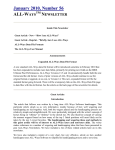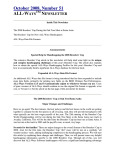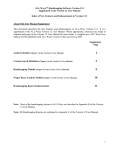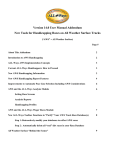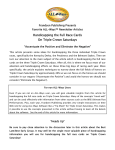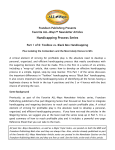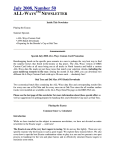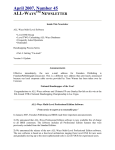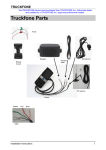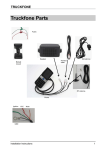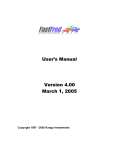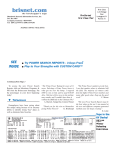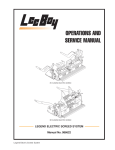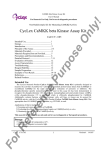Download January 2009 Number 52
Transcript
January 2009, Number 52
ALL-WAYSTM NEWSLETTER
Inside This Newsletter
2008 Breeders’ Cup Follow-up
Handicapping All Weather Surface Races from Oak Tree to Santa Anita
Turf to Synthetic Surface Advantage: Fact or Fiction?
Guest Article: Aqueduct Inner Dirt Tract
Winter: A Good Time to Get Started with ALL-Ways
For ALL-Ways Handicappers Only
• Windows Vista
• Batch Download Files
Announcements
Windows Vista
Just to confirm, ALL-Ways Software is 100% compatible with the Windows Vista operating
system. Also, Microsoft has fixed the “bug” in Windows Vista that was preventing the
underlining of printed characters and words. See the last page of this newsletter for more
information.
ALL-Ways Batch Download Data Files
ALL-Ways Batch Download data files will be available in February, providing a simple and
very economical way to build “instant” large ALL-Ways Databases for most North American
tracks. See the last page of this newsletter for more information.
A Chain Reaction
We started preparing for this issue of the quarterly ALL-Ways Newsletter by taking a look back
at the 2008 Breeders' Cup races run during the Oak Tree Meet at Santa Anita this past October.
Our focus was on the races run on the new Pro-Ride synthetic racing surface. Some revelations
came out of this analysis that started a "chain reaction" of sorts. More specifically, besides the
actual Breeders Cup races, we went on to analyze the all weather surface under card races as
well. This caused us to then look at the full 2008 Oak Tree Meet. Then, because of some things
we spotted, we went on to look at all tracks with synthetic racing surfaces to see if we could
support or "shoot down" the anecdotal concept that horses with some turf racing success in their
backgrounds have an advantage when switching to an all weather synthetic surface. We decided
to share all of this with our readers.
2008 Breeder’s Cup Follow-up
There are two solid reasons to cover this subject now. First, just like the 2008 edition, the 2009
Breeders Cup will also be run during the Oak Tree Meet at Santa Anita. Whatever we can learn
from the 2008 Breeders Cup should help us handicap the 2009 BC races as well. The second
reason to cover this subject now is to provide some insights that will help handicap the races
during the 2009 Santa Anita meet which started in late December and will go on into April 2009.
We start now by looking at the eight Breeders' Cup races that were run on the new Pro-Ride
synthetic surface at Santa Anita. Going into the Breeders' Cup, we expected closers ("P" and "S"
horses) to do particularly well on the all weather surface. We also suspected foreign horses
would to do well, primarily because they usually have good turf performances in their
backgrounds. At least on an anecdotal basis, good turf runners were believed to have an
advantage when moving to a synthetic surface.
The following are the specific questions we asked regarding the top three finishers in each all
weather surface race:
•Which running style(s) did the best?
• How many of the top finishers were designated by ALL-Ways software as one of the top tier of
"Best Late" horses? The ALL-Ways Late Rating is a compound rating that is the sum of the
horse's Speed rating plus Final Fraction pace rating.
• How many of the top finishers were designated by ALL-Ways as one of the four best Key
Horse Candidates?
• How many of the top finishers were included in the ALL-Ways Top 10 Speed Performances
list? These Top 10 performances are determined by looking at the final speed figures for every
horse's last five races and picking out the best ten performances. A horse often has multiple
positions in the Top 10 list.
• How many of the top finishers had some type of good performance in turf races?
• How well did foreign horses perform?
Here, in chart form, is what we learned when examining the eight all weather surfaces races that
were part of the Breeders' Cup.
The Eight Breeders Cup All Weather Surface Races
Running
Style
Win
Place Show Total
E
EP
P
S
Unknown
0
0
4
2
2
1
2
1
3
1
1
1
4
2
0
Late
Key
Top 10
Turf
5/6
6/6
5/6
4/8
5/7
5/7
7/7
6/8
6/8
4/8
7/8
2/8
2
3
9
7
3
16/21
15/21
19/21
12/24
Note: Foreign horses without a race in North America won two races and placed in
another. There was no information about these horses other than BRIS Class figures. This
explains the three unknown running styles and the missing data for two win positions and
one place position.
The horse running style figures are very enlightening. Not a single race was won by an Early
("E") horse or an Early Presser ("EP") horse. In fact, only five such horses finished in-the-money
in all eight races! In contrast, 16 of the 21 known running styles for the in-the-money horses
were mid-pack Pressers ("P") or come from behind Sustainer ("S") horses. Note that these
figures are based on the running styles assigned by ALL-Ways Software using a special
proprietary method.
Horses designated by ALL-Ways as the Best Late runners took 16 of the 21 in-the-money
positions (76%). Horses designated by ALL-Ways as good Key Horse Candidates took 15 of the
21 in-the-money positions (71%) and 19 of the 21 in-the-money horses were in the ALL-Ways
Top 10 Speed Performances list, a whopping 90%. Finally, half of the 24 top 3 finishers,
including the three foreign horses, had good turf performances in their background. We know
this resulted in solid Impact Values for good turf horses, but the sample is too small to form firm
conclusions. We will cover more on this subject later.
Now, let's look at the five all weather surface under card races run on 2008 Breeders' Cup Friday
and Saturday.
The Five Under Card All Weather Surface Races
Running
Style
Win
E
EP
P
S
1
1
1
2
1
1
3
0
0
2
2
1
3/5
5/5
4/5
2/5
5/5
4/5
4/5
4/5
4/5
3/5
4/5
4/5
Late
Key
Top 10
Turf
Place Show Total
2
4
6
3
12/15
12/15
12/15
10/15
"E" and "EP" horses did somewhat better in the under card races than in the actual Breeders' Cup
races. But, "P" and "S" horses still took 9 of the 15 win, place and show positions and, not
shown, they also took 4 of the 5 fourth place finishes as well. The other data is very similar to
that of the actual Breeders' Cup races, except that horses with evidence of some good turf
performance(s) in their background took 67% (10 of 15) of the in-the-money finishes, up from
50% in the actual BC races.
Any Conclusions? You cannot really draw firm conclusions from the results of just the 13 all
weather surface races run during the two day Breeders' Cup. With that said, these races all played
out in a manner that supports the contention, particularly for high caliber races, that the old
heavily early speed favoring dirt track of Santa Anita has changed to an all weather surface that
is far more kind to closers. These races played out pretty much as predicted in the ALL-Ways
Newsletter for October 2008. This will come in handy when its time to handicap the 2009
Breeders' Cup, also at Oak Tree/Santa Anita. And, in the article that follows, we are going to
look at AWS "dirt" races run during the entire Oak Tree fall meet.
Handicapping All Weather Surface Races
From Oak Tree to Santa Anita
A new Pro-Ride synthetic racing surface was installed at Santa Anita in time for the full 2008
Oak Tree Meet, including the 2008 Breeders' Cup. We used the ALL-Ways Impact Value
Analysis feature to automatically determine the best and most profitable handicapping factors
during the Oak Tree Meet that should carry over well into the 2009 Santa Anita meet.
Specifically, we looked at the 53 non maiden sprints, 52 non maiden routes and 52 maiden
sprints run on the new all weather surface. Reminder: An Impact Value (IV) greater than 1.0
means that qualifying horses win more than their fair share of races. An IV below 1.0 means the
horses win less than their fair share of races. A $2 ROI (return-on-investment) above $2
represents a profit while a number under $2 is a loss. We are now going to look at the results of
these analyses including some focus on the pace implications of these races.
Oak Tree/ Santa Anita Non-Maiden Sprints on the New Pro-Ride Surface
First, here are the IVs for the four basic horse running styles:
Winner Running Style Impact Values
"E"
.60
"EP"
1.30
"P"
1.26
"S"
.65
We can see that the track was still unfavorable to the Early ("E") horses as it was for the
Breeders' Cup races, but Early Pressers ("EP") fared much better. This is to be expected for
normal level races as opposed to the high caliber BC races. One very interesting thing to note is
that there were 97 "EP" horses in these 53 races. Had you wagered $2 to win on every one of the
97 "EP" horses, you would have achieved a net profit of $1.18 for every $2 wagered. Wow! Here
are the IVs are for the BRIS Early Pace Rating, which is measured from the gate to the 2nd Call.
BRIS Early Pace Rating
Rank
IV
$2 ROI
1
.84
$0.96
2
1.57
$2.25
3
1.65
$3.40
This shows that horses with the fastest pace rating at the 2nd Call won less than their fair share
of races (0.84) and, had you wagered on each one, you would have lost $1.04 for every $2
wagered. "E" horses would normally have the highest Early Pace Rating. But, now look at the
2nd and 3rd ranked horses. They won more than their fair share of races and returned nice profits
for $2 win wagers. Our theory is that early running "E" horses that, by definition, need the lead,
often burn themselves out on the new synthetic surface. On the other hand, "EP" horses, by
definition, are able to rate behind a fast running leader at the 2nd Call and are thus still able to
have a good stretch run. Now, here are the overall best handicapping factors for these nonmaiden AWS sprints.
Best Handicapping Factors for AWS "Dirt"
Non-Maiden Sprints at Oak Tree/ Santa Anita
Factor
IV
$2 ROI
BRIS Class
Scott PCR
BRIS Speed P/L
BRIS Combined P/L
BRIS Late P/L
Comprehensive
1.83
1.55
2.28
2.13
2.30
2.29
$1.65
$2.15
$3.58
$3.46
$2.26
$1.92
PCR = Scott Performance Class Rating
P/L = Pace Line Race
Combined = Early Pace +Final Fraction
Late = Final Fraction +Speed
A pace line race is the single race in the horse's past performances that best matches today's race.
ALL-Ways software uses a sophisticated approach to selecting the pace line race for a horse that
includes giving priority to other races run on an all weather surface. This method has proven to
be very powerful for handicapping AWS races.
Oak Tree/ Santa Anita Non-Maiden Routes on the New Pro-Ride Surface
Here are the IVs for the four basic horse running styles in non maiden AWS routes.
Winner Running Style Impact Values
"E"
1.43
"EP" "P" "S"
1.01
.70 1.09
We see that the AWS routes were much kinder to Early ("E") runners. This may be explained by
the fact that there are fewer "suicidal" pace races in routes and, in fact, the pace in routes simply
tends to be slower than that in sprints. This makes it easier for "E" horses to hang on down the
stretch. It is not shown here, but when we look at Quirin Speed Points for AWS routes, which is
a measure of a horse's propensity to be on the lead at the 1st Call, we see that horses ranked first
win only 1.05 their fair share of races and generate a loss of 90 cents for a $2 flat win wager. The
2nd ranked horse for Quirin Speed Points win 1.47 times their fair share of races and yield a flat
bet profit of $1.35 for each $2 wagered. This tells us that horses that run fast right out of the gate
are at a disadvantage on the all weather surface. Now, here are the best handicapping factors.
Best Handicapping Factors for AWS "Dirt"
Non-Maiden Routes at Oak Tree/ Santa Anita
Factor
BRIS Class
BRIS Speed 2/3
Hall Speed P/L
Hall Early Pace 2/3
Hall Total 2/3
BRIS Late 2/3
IV
$2 ROI
2.04
1.92
2.65
1.71
1.82
2.24
$1.49
$1.65
$2.52
$2.46
$2.97
$2.97
2/3 = average of best 2 out of the last 3 races
Total = Hall Early Pace +Hall Speed
Late = BRIS Final Fraction + BRIS Speed
The Hall pace and speed figures are very unique and they are exclusive to ALL-Ways software.
The Hall figures use the concept of "Conservation of Energy" to normalize all of a horse's past
performances to what the pace and speed figures would be in today's race at the exact distance
and surface of today's race. The Hall figures have proven to be very effective for analyzing how
well a horse will be able to handle the all weather surface and tend to yield good $2 ROI win
wager profits.
At first glance, the Hall Total (Early Pace + Speed) and BRIS Late (Final Fraction + Speed)
would seem to be at odds with each other. However, this is very helpful information. It tells us
that a good way to approach these races is using the Best Early/Best Late strategy when
formulating our wagers. (See NL #18).
Oak Tree/ Santa Anita Maiden Sprints on the New Pro-Ride Surface
Finally, let's take a look at maiden sprints run on the all weather surface. We are not looking at
running styles simply because the first time starters in these maiden races do not allow for
meaningful running style information. Here are the best handicapping factors.
Best Handicapping Factors for AWS "Dirt"
Maiden Sprints at Oak Tree/ Santa Anita
Factor
IV
$2 ROI
BRIS Wgt. Total
BRIS Class
BRIS Speed Last
BRIS Total 2/3
Hall Late 2/3
BRIS Prime Power
3.34
2.42
2.77
3.63
3.02
3.34
$2.85
$1.40
$2.11
$2.68
$2.15
$2.06
2/3 = average of best 2 out of the last 3 races
Total = BRIS Early Pace + BRIS Speed
Late = Hall Final Fraction + Hall Speed
Wgt. = Weighted moving average, a measure
of a horse's current form
A reminder: ALL-Ways software handicaps first time starters using workout, trainer, jockey and
pedigree information and integrate this with all the horses in the race creating an integrated odds
line. It is always wise to look at any first time starters ALL-Ways designates as contenders. They
often do well at big prices. Notice once again that the Best Early/Best Late approach is in play
based on the BRIS Total and Hall Late figures.
Summary
We believe understanding and using the pace and handicapping factor information in this article
will give you a significant edge when handicapping Pro-Ride surface races during the 2009 Santa
Anita meet.
Turf to Synthetic Surface Advantage
Fact or Fiction?
As more tracks have switched to synthetic racing surfaces, we have begun to hear the theory that
horses that do well in turf races have an advantage when competing on the new synthetic
surfaces. In the Breeders Cup recap article earlier in this newsletter we saw that half of the inthe-money finishers in the Breeders' Cup AWS races were horses with some turf success in their
backgrounds. We also saw that two thirds of the top three finishers in the five under card AWS
races also had good turf experience.
In view of all of this, we decided to use the ALL-Ways Impact Value Analysis to further analyze
"dirt" races run at nine North American tracks with synthetic racing surfaces. We analyzed 3,325
non maiden AWS races. The obvious first thing we looked at was the BRIS Turf Class Rating
provided for many of the horses in these races. Two things stood out. One is that the top
ranked Turf Class horses in these races had positive Impact Values at all nine tracks. The
typical Impact Values were in the 1.30 to 1.50 range. The best IVs were for Del Mar AWS
sprints (1.60), Woodbine AWS routes (1.98) and Keeneland AWS routes (2.39). These high IVs
also yielded solid profits as well. This would seem to indicate the favorable turf to AWS theory
was valid. However, the second thing that stood out was that the BRIS True Class Rating, which
does not include turf races when today's race is on an AWS "dirt" surface, actually yielded
generally higher IVs at most of the nine tracks. This would seem to indicate that the top rated
turf horses were simply good horses and could be expected to win at a decent clip. We do not
believe these Turf Class results necessarily supported the theory. But, we looked further.
The next thing we did was to look at a special type of rating in ALL-Ways software named
"Effort". This rating is done individually for each horse's past performances on dirt, on turf and
on muddy tracks. For example, for the Turf Effort Rating, ALL-Ways looks at the horse's turf
race performances and assigns an overall rating of 4, 3, 2, 1 or 0 (zero) with four being the best.
A rating of 4 is only given to horses with a turf win. Any good race on the turf will give the
horse a minimum "1" rating. Looking at the Turf Effort Ratings and the Dirt Effort Ratings
lets us directly compare the value of turf versus dirt past performances leading into today's
all weather surface race. The charts below show the results of this analysis. The specific
synthetic track material is also shown for all the tracks.
All Weather Surface "Dirt" Sprints
Track
DMR
APX
KEE
WOX
TPX
HOL
GGX
PID
OSA
Impact Values
4 Dirt
4 Turf
Effort
Effort
4 Dirt
Effort
1.55
1.37
1.24
1.51
1.57
1.56
1.63
1.59
1.46
$2.26
$1.95
$1.37
$2.05
$1.23
$1.67
$1.85
$1.36
$1.62
1.57+
1.99+
1.69+
1.68
0.61
2.65+
1.64
2.27+
2.21+
$2 ROI
4 Turf
Effort
$3.39+
$2.72+
$2.64+
$2.01
$0.85
$4.38+
$1.75
$1.91
$1.86
All Weather Surface "Dirt" Routes
Track
Impact Values
4 Dirt
4 Turf
Effort
Effort
$2 ROI
4 Dirt
4 Turf
Effort
Effort
DMR
APX
KEE
WOX
TPX
HOL
GGX
PID
OSA
0.97
1.35
0.94
1.18
0.97
1.24
1.26
1.28
1.26
$1.21
$1.91
$1.33
$1.06
$1.30
$1.38
$1.31
$0.99
$1.27
1.70+
1.83+
2.12+
1.51+
1.55+
1.20
1.84+
1.86
0.92
$2.42+
$2.60+
$2.56
$2.24+
$2.59+
$1.35
$2.35+
$2.03+
$1.60
PolyTrack: Del Mar, Arlington, Keeneland, Woodbine, Turfway
Cushion Track: Hollywood
Tapeta Footings: Golden Gate, Presque Isle Downs
Pro-Ride: Oak Tree/Santa Anita
Here is how to read these charts. Looking at Arlington Park AWS sprints, we see that horses
with a Dirt Effort rating of 4 have an IV of 1.37 indicating they win 1.37 times their fair share of
races. A $2 flat win bet on all these horses returned $1.95 for a small loss. Horses with a Turf
Effort rating of 4 have an IV of 1.99 and returned $2.72 for every $2 wagered. Note also that
the "+" signs are very positive, indicating solid Impact Values and good $2 ROI figures for
horses with a 3 or 2 rating. Using Arlington again, here are the IVs and ROIs for the top Turf
Effort ratings:
APX Turf Effort Rating
Rating
4
Impact Value 1.99
$2 ROI
$2.72
3
2
1.70 1.55
$2.32 $2.46
Note that when we looked at the 4 and 3 and 2 Turf Effort Ratings for all nine tracks and both
sprints and routes, a whopping 50 of the 54 Impact Values were very positive.
Other observations: The Turf Effort IVs were better, generally substantially better, than their
counterparts for Dirt Effort in every case except AWS sprints at TPX and AWS routes at HOL
and OSA. Also, two thirds of the Turf Effort $2 ROIs were positive while only two dirt $2 ROIs
were positive. Finally, there were 648 horses with a 4 rating in the 3,325 races, which is
approximately one in every 5 races. Of course there are even more horses with a Turf Effort
Rating of 3 or 2.
Summary
While this analysis may not prove the turf to all weather surface advantage theory, it certainly
does support it. This coupled with the one in five race occurrence of a 4 rating makes this a
candidate for a good spot play angle when playing all weather surface races at these tracks. You
would certainly not want to ignore these horses in your Exacta, Trifecta or Superfecta wagers or
your multi-race wagers as well.
Guest Article
Aqueduct Inner Dirt Track
As a user since 1997 I just wanted to let you know how unbelievable ALL-Ways software has been at Aqueduct
Inner. With over 2,100 races in my database, the Pace Line Report has been super. I have had numerous triple
digit Exactas the first two weeks of the meet and price horses ranging from $20.00 to $80.00. I suggest users
concentrate on the Pace Line Report and use horses with high Combined Ratings and high First and Second Call
Ratings. These are from the "Hall" section. Also, an ALL-Ways Race Pace Shape of EP-EP will produce the
winner with an "EP" running style. In Lone Early races, any "E" horse is a must use. Pay attention to inside post
positions as this helps move up the rating of horses, in particular, those with any tactical speed. I have found that
these Aqueduct Inner Track races produce the best value in New York along with Saratoga. Perhaps you can
share this in your Newsletter. Anyway, have a Merry Christmas!
Al Franzone
Winter: A Good Time to Get Started with ALL-Ways
Serious horseplayers who are analytical and investigative have found a powerful partner in ALLWays Software. ALL-Ways includes a large "toolbox" of powerful handicapping tools, including
extensive information that is not available from any other source. ALL-Ways also includes a
large "toolbox" of analytical tools including the Impact Value Analysis, Top 3 Analysis, Gap
Analysis and the powerful Angle Assistant. These powerful handicapping and analysis tools and
unique information provide the ALL-Ways user with a significant edge over their competition,
specifically the other horseplayers playing the same races. For a more thorough description of
ALL-Ways, we suggest reading the brief paper titled "How ALL-Ways Works" that is
posted on the ALL-Ways Free Software Page on the BRIS Website.
Some new ALL-Ways handicappers prefer to aggressively jump in and learn all about ALLWays in rapid fashion. This is certainly a valid approach. Many other new ALL-Ways
handicappers prefer to follow the built-in Multi Level design of ALL-Ways, moving up through
the logical progression from Level ONE up to Level FOUR at their own pace. We refer to this
process as "From novice to expert at a reasonable pace." Here is how to get started:
1) Download and install ALL-Ways Software from the ALL-Ways Free Software Page on the
BRIS Web site. The comprehensive ALL-Ways User Manual is also available there, although we
recommend calling BRIS at 800 354 9206 and having them mail a printed copy of the manual in
a 3-ring binder for a nominal S&H charge. 2) After installing the software, print and read the
brief papers that are in the ALL-Ways Program Group titled "How ALL-Ways Works" and
"Quick Start Guide", the latter includes a practice handicapping session. 3) Then, read Chapter
One in the User Manual and follow the directions in Chapter 2. You will be referred to other
parts of the User Manual if more information is desired.
Related ALL-Ways Newsletters
All ALL-Ways Newsletters as well as a Major Topic Index are posted on both the Frandsen
Publishing and BRIS Web sites and they are absolutely free.
Article
Pace Handicapping (Race Pace Shapes)
Best Early-Best Late
Quirin Speed Points
Hall Pace and Speed Figures
Impact Values vs. Percentages
ALL-Ways Multi-Level Software
1) Getting started with the Basics
2) Unleashing ALL-Ways Databases
3) Analysis and Control
4) The Ultimate Handicapping Tools
NL#
#3
#18
#13
#16
#32
#44
#45
#46
#47
For ALL-Ways Handicappers Only
Windows Vista: There was a small "glitch" in the Vista operating system that would allow a
printed character to be in bold type, but not underlined. Microsoft has solved the problem in
Vista Service Pack 1. Here are the simple steps to follow to install the Vista update: 1) Go to
www.microsoft.com. 2) Click on SUPPORT to drop down a list. 3) In the Product Support
group, select Windows Vista Solution Center. 4) Under Update Vista, select Download Service
Pack 1 and follow the directions.
Batch Download Files: During 2008, BRIS and Frandsen Publishing offered special ALL-Ways
Batch Download files for tracks running on synthetic racing surfaces. These files included large
numbers of ALL-Ways Data Files and matching Exotic Results Data Files for past race cards at
these individual tracks. After downloading a Batch Download file, ALL-Ways can automatically
unzip all the batch files and automatically process all the ALL-Ways Data Files and
automatically process all the results files. Starting sometime in February 2009, BRIS and
Frandsen Publishing will offer similar ALL-Ways Batch Download files for past races at most
tracks in North America. The reduced prices for these files will make it very easy, very fast and
very economical to instantly build large ALL-Ways Race Database(s) for your favorite track(s).
© Copyright 2009
Frandsen Publishing Corporation
PO Box 1439
Minnetonka, MN 55345
All Rights Reserved
How to contact Frandsen Publishing
Phone: 952.937.9180
E-Mail: [email protected]
Website: www.frandsen.com
Be sure to check the What’s New page on our Website for
the latest announcements and alerts.











